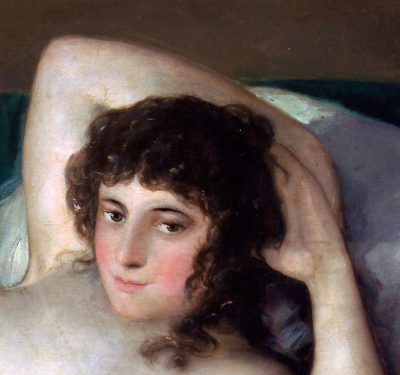The Nude Maja or La Maja Desnuda is a painting by the Spanish artist Francisco Goya. It is a work of oil on a large canvas, measuring 97cm x 190cm and was painted sometime between 1797 and 1800.
The work was most likely commissioned by the Spanish Prime Minister of the time, Manuel de Godoy.
Francisco Goya was a romanticist and is widely regarded as the most important Spanish artist of his era. Highly successful within his own lifetime he marks an artistic turning point as one of the last Old Masters and one of the first modern painters.
His talents led him to an appointment as a court painter to the Spanish Crown and his early portrait works detail a wide array of the Spanish royalty and aristocracy.
La Maja Desnuda depicts a nude woman laying back on a spread of pillows with the subject looking directly at the viewer with her hands resting behind her head. The background is dark and without feature, the light of the painting is solely focussed on the subject. Much has been made by art critics of the gaze of the model as she confidently smiles at the viewer without shame.
Goya also painted a near identical version of the painting entitled La Maja Vestida. In this piece the setting and pose are identical but the subject is fully clothed. The paintings are commonly presented as a pair and were commissioned at the same time. It has been reported that Manuel de Godoy originally hung the clothed version of the painting in such a manner that a pull of a cord activated a pulley mechanism that then revealed the La Maja Desnuda to the viewer.
Maja (the feminine term of majo) was the name given to lower class members of Spanish society that were characterised by their flamboyantly traditional outfits and cheeky demeanour. They were common in Madrid in the 18th and 19th centuries and were the favoured subjects of many Spanish painters.
Speculation over the identity of the model remains to this day. Many consider her to be Pepita Tudó, Goya's young mistress at the time. Others speculate that she is María Cayetana de Silva, 13th Duchess of Alba who was also painted twice before by Goya and with whom there had been rumours of a romantic affair. It is also been suggested by art historians that the model is a composite of several women to create the final subject depicted.
La Maja Desnuda is one the first earliest examples of Western classical art that depicts the pubic hair of a nude woman without any negative associations. Previously any paintings revealing so much of a woman were of prostitutes or similar. The painting still upset many members of the church whilst also causing a sensation among public viewers.
In 1808 the painting was in the collection of Prime Minister Manuel de Godoy. Following political upheaval, Godoy was forced to flee to Rome in exile and the court of King Fernando VII seized Godoy's collection, amongst other riches. In 1813 the piece was discovered by an investigator from the Spanish inquisition along with a number of other pictures that the Inquisition regarded as obscene and salacious.
Godoy and his art curator, Don Francisco de Garivay, were summoned and questioned by an Inquisition at a tribunal and were forced to identify the artist of the La Maja Desnuda and La Maja Vestida. The Spanish Inquisition subsequently questioned Goya in 1815 and demanded to know for what reason he had painted them. The reply given by Goya is unknown but it is theorised that he evaded further prosecution by perhaps likening his work to that of previous similar pieces by Titian and Velázquez, both artists admired by the Catholic Church.
The Inquisition held the painting until 1836 after which it entered the collection of the Royal Academy of Fine Arts of San Fernando where it resided until 1901. From that time until the present day it has been on display in the Prado Museum, Madrid.




